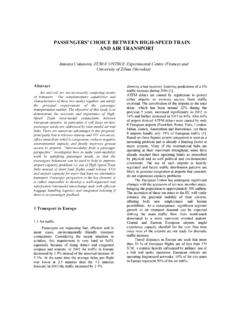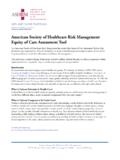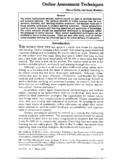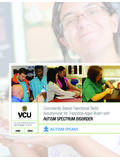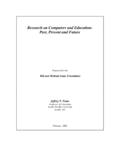Transcription of EFQM SELF-ASSESSMENT REPORT - EUROCONTROL
1 EUROCONTROLEUROCONTROL EXPERIMENTALCENTREEFQM self -ASSESSMENT2003 AWARD SIMULATION APPROACHV ersion May 2003 EUROCONTROL EXPERIMENTAL CENTREEFQM self assessment 2003 version 2 of 60 DOCUMENT APPROVALThe following table identifies all management authorities that have successively approved the presentissue of this AND SIGNATUREDATEE ditor in ChiefEric WATKINS02 May 2003 Director EUROCONTROLE xperimental CentreJean-Marc GAROT02 May 2003 DOCUMENT DATEAUTHOR(S) March 2002 List 1 below2002 edition submitted for external August 2002 Eric WatkinsIncorporation of extensive comments from April 2003 List 2 belowFirst consolidated draft for the 2003 May 2003 List 2 All chapters updated, comments from coremanagement members edition submitted for external assessmentList 1 Editor in Chief:Eric WATKINSC hapter Authors:Marc BISIAUXJ anedig DA COSTATed ELLIFFP eter ERIKSENAndy HARVEYR oger JERRAMF rederic MASC olin MECKIFFDirk SCHAEFEREric WATKINSList 2 Editor in Chief:Eric WATKINSC hapter Authors:Marc BISIAUXM arco GIBELLINIAndy HARVEYPaul HUMPHREYSR oger JERRAMN igel SYLVESTER-THORNEEric WATKINSEUROCONTROL EXPERIMENTAL CENTREEFQM self assessment 2003 version 3 of 60 TABLE OF CONTENTSOVERVIEW.
2 41 LEADERSHIP ..102 POLICY AND STRATEGY ..183 PEOPLE ..244 PARTNERSHIPS AND RESOURCES ..305 PROCESSES ..396 CUSTOMER RESULTS ..457 PEOPLE SOCIETY RESULTS ..519 KEY PERFORMANCE ..60 EUROCONTROL EXPERIMENTAL CENTREEFQM self assessment 2003 version 4 of 60 OVERVIEWC ontext of this submissionThis submission document represents the 5thEFQM SELF-ASSESSMENT that the EEC has carriedout since the first SELF-ASSESSMENT in 1998. Seethe section Journey to Excellence below. This isthe 2nd time that the award simulation approachhas been used, the first being in 2002. In 2002and this time in 2003, the submission documenthas been submitted to an external team ofassessors, led by a qualified efqm seniorassessor, in order to guarantee a totally objectiveassessment and scoring. The feedback from the2002 SELF-ASSESSMENT has been digested by theEEC and has been used to improve EECfunctioning and submission is being made at a time when theEEC is undergoing an important transition.
3 Majorinitiatives have taken place in the ATM sectornamely the ACARE initiative of the EuropeanCommission and the formation of new industryalliances. In order to meet the challenges of thisrapidly changing context, the EEC conducted a farreaching strategy review in the 2nd half of 2002followed by a reorganisation to align the EECstructure with the revised strategy. The former 9business areas (pre 2003) were readjusted andconsolidated into 6 business areas in order to fullyalign with ACARE and the revised ATM2000+strategy. This transitional situation should be keptin mind by the The EUROCONTROL Experimental Centre (EEC)was officially established as an external service ofthe EUROCONTROL Agency on 10 June initial responsibilities were defined as: operational research and the testing of ATCmethods operational demonstrations of the validity ofthe ATC system proposed operational and technical evaluation of controlcentre equipment The EEC was the first establishment in the worldto execute a totally digital real time simulation forATC.
4 The resources and scope of the EEC have beengradually increased over the years and the EEChas become a leader in the provision of ATMsimulation services and a major ATM/CNS R&Dcentre. Changing market context From its inception and for most of its existence,the EEC has been in a stable public serviceenvironment. Despite fluctuations, the steadyEuropean economic growth has produced asteady growth in the demand for air travel with aconsequent requirement for ATC systems toconstantly deliver commensurate increases incapacity. This constant renewal and upgrade ofATC systems and airspace organisations has ledto significant investments at the EEC both forresearch and development and for ATCsimulations and the demand has usuallyexceeded the EEC s work capacity. Competition for the EEC has been virtually non-existent since both ATC service provision andnational research and development centres weregovernment activities.
5 Cooperation andcollaboration has taken place but the absence ofan overall view and management of research anddevelopment in Europe, has led to duplication andoverlap of activities and wasted investment. Since the beginning of the 90s, many States haveprivatised or corporatised their ATS providersand/or their R&D Centres. The EEC now findsitself in an environment where competition and theneed to demonstrate cost effectiveness must becarefully married with collaboration to ensure themost efficient use of the overall Europeaninvestment in ATM research and this context, the EEC has regularly reviewed itsposition and its role. Extensive discussions withthe main stakeholders, through the EECC onsultation Group took place to define for eachtype of activity the funding, the work allocationmechanisms and the EEC role. The EEC doeshold a unique position in European ATM, it beingthe only European ATM R&D establishment, butnevertheless in many aspects it is a peer amongseveral many years, the EEC has gradually build astrong partnership with the EuropeanCommission.
6 In Q1 2003 after long negotiationsinside and outside the Agency, this partnershiphas been further consolidated with EATM, and theEEC has been given full responsibility for ATMR&D in Europe. This transition, referred to at thebeginning of this chapter, will see the EEC andthe European Commission constitute a JointProgramme Board which will oversee ATM R&DEUROCONTROL EXPERIMENTAL CENTREEFQM self assessment 2003 version 5 of 60in Europe articulated through an ATM R&DMaster Plan. Detailed working arrangements arecurrently being of the EECThe mission of the EEC is to carry out researchand development in order to improve Air TrafficManagement in deliver this mission through 6 business areas:EEC Business Areas (2003)APTA irport throughputERISEATMP reference industry-based simulationplatformINOI nnovative researchNCDN etwork capacity and demand managementSEES ociety, Environment and EconomySPPS ector Safety and ProductivityAs any research centre, the activities compriseexperiments, studies, validation, tests, andprototyping.
7 A major tool is simulation, rangingfrom analytical modeling through to real timesimulation and field trials. Simulations are aninstrument for evaluation, validation andacceptability testing of R&D products. They arealso provided as a service to member states andANSPs in order to support improvement actionssuch as airspace reorganisation, changes inworking procedures, and the introduction of newtools. A major EEC activity is softwaredevelopment, of simulators, tools, andmiddleware, and of prototype components of work of the EEC is organised as a set ofprojects, and a project is managed by one of thebusiness areas. The totality of the projectsconstitute the work programme. The followingtypes of deliverable are project outcomes: Reports Publications in learned journals andconferences simulators tools prototype ATM system components demonstratorsDifferent projects in the EEC work programmeaddress different periods in the research timespectrum, from short term through medium termto long term.
8 Experience shows that there isnormally a constant of 10-20 years to bring newconcepts into projects in deliver benefit in the short example, NCD provides a unique capacityplanning service to the ATM community to deliverATFM delay forecasts and yearly capacity plansand to set short-term capacity targets for projects explore the feasibility and benefitsof new airspace organisations, and new workingmethods as applied to current operationalsystems, and recommendations are oftenimplemented in the short of the other business areas are concernedwith medium to long term research. Oneexample, and a key EEC project is objectives are essentially to determine theoperational feasibility, applicability, and potentialbenefits, in terms of safety, capacity and overallefficiency, of partial delegation of separationassurance from ground ATC to aircrew. If this lineof research delivers the expected benefits,operations could be in the 2015 EEC develops a large range of softwareapplications for its own use.
9 It is not the businessof the EEC to develop and deliver operationalproducts, that is the business of industry, butsimulators, tools, prototypes and demonstratorswhich achieve a high level of maturity can interestthe ATM community at large. These spin-offproducts are made available normally free ofcharge. See chapter 6 Funding and ResourcingAll 2003 budget figures in this REPORT correspondto the state at the time of writing. The budget ofthe EEC is a component of part 1 of the Agencybudget, which is funded by Member Statecontributions according to Agency rules. In 2003this amounts to MEUR and covers staffcosts, operating expenditure and investmentcredits. This EEC budget is augmented by in the form of delegations from othersponsors, both internal and external to theAgency, in payment for work delegationsOriginAmount(MEUR)Other Agency directorates,mainly EATM and to the Agency,mainly EuropeanCommission, ENAV, the addition of delegations, the total budgetmanaged by the EEC in 2003 is chart below shows the amount of resourcesallocated to the different business areas,enablers, and support in 2003.
10 Funds areallocated based on agreed plans in the BusinessPlan complemented by subsequent negotiationduring budget EXPERIMENTAL CENTREEFQM self assessment 2003 version 6 of 60 The EEC staff complement is 272 budgetary postsof which 15 are frozen to reduce overall Agencystaff costs resulting in 257 posts which can befilled. 252 staff are currently in post. This staffcomplement is supplemented with more than 200external persons made up of contract staff andstudents and seconded staff from nationaladministrations. The EEC building is set on a siteof some square metres. It has a total floorspace of some square metres whichcomprises office space, meeting rooms, aconference facility, experimental rooms andworkshops, in addition to a showroom and the realtime simulation area consisting of two controlrooms, a demonstration room and a pilot OrganisationThe EEC operates a matrix organisation across the whole of its organisation, core business and are 6 business areas and 4 principal business enablers on the vertical axis and 6 centres of expertiseon the horizontal axis.
